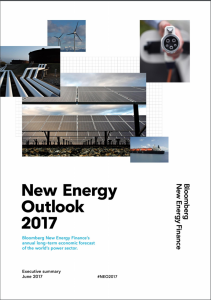Full Title: New Energy Outlook 2017 Executive Summary
Author(s):
Publisher(s):
Publication Date: June 1, 2017
Full Text: Download Resource
Description (excerpt):
Welcome to the 2017 New Energy Outlook (NEO), Bloomberg New Energy Finance’s annual long-term analysis of the future of energy. Focussed on the electricity system, NEO combines the expertise of over 65 in-house country and technology-level specialists in 12 countries to provide a unique assessment of the economic drivers and tipping points that will shape the sector to 2040.
What sets NEO apart is that our assessment is focussed on the parts of the system that are driving rapid change in markets, grid systems and business models. These include the cost of wind and solar technology, battery storage, electricity demand, electric vehicles and consumer dynamics. To say something meaningful about the evolution of the system as a whole, we also analyse coal, gas and oil markets and their fundamentals.
In the near term, our market projections are based on an assessment of policy drivers and Bloomberg New Energy Finance’s proprietary project database, which provides a detailed understanding of planned new build, retrofits and retirements, by country and sector. In the medium to long term, the forecast is driven by the cost of building different power generation technologies to meet projected peak and average demand, country by country. The modelling then preferentially deploys least-cost technology options that change over time in line with shifting capital, operating and financing costs.
We explicitly model small-scale and large-scale battery systems, as well as taking a view on growth of demand response and charging electric vehicles. These new sources of flexibility allow for more dynamic balancing of supply and demand and become particularly important in markets where large amounts of variable wind and solar are deployed and conventional assets retire.
It is important to note that NEO explicitly removes renewable energy subsidies once they have run their course, and does not assume national climate targets are met, unless a mechanism to ensure compliance has been legislated. For example, we not include the US Clean Power Plan or assume the Paris Agreement is achieved.
The objective of the study, therefore, is not to provide a political document or a BNEF house view, but to highlight the changing fundamentals of renewable and conventional energy, how these may shape the future energy landscape and what opportunities and risks may arise for market participants as a result. Since NEO is a least-cost optimization exercise, for it to come true would require significant market reform and new price signals to maximise value from new technologies – a topic of ongoing focus for the analyst team at BNEF.
